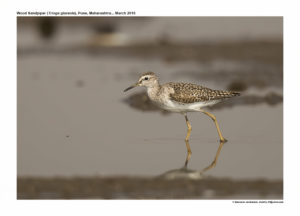Wood Sandpiper

Wood Sandpiper Tringa glareola
Etymology:
- Tringa : Greek word for trungasthrush-sized, white-rumped wading bird that bobs its tail, mentioned by Aristotle
- Glareola : Latin word for gravel
Vernacular Names: Hindi: Chupkabatan, Chobaha, Titvari, Sans: Van jalrank, Pun: China retalchaha, Ben: Balubatan, Guj: Vanatutvari, Mar: Dirghalav, Thipkewalatutari, Ta: Vayalullan, Kottan, Te: Chinnaulanka, Podalaulanki, Mal: Kata kokku, Sinh: Siliwatuwa, Tapkilithuthvari, Mar: ThipkedarHirvatutvar
Distribution in India: Widespread Winter visitor in India.
Description: Size of 18-21 cm.It is a small, graceful sandpiper; head, neck and breast finely streaked grey-brown; supercilium and throat are white; upperparts black-brown with white spots, underparts white. It has long neck and legs. The female averages slightly larger and acquires breeding plumage earlier. The non-breeding adult has browner and less spotted upperparts; breast washed grey and less streaked; supercilium more distinct. The juvenile like non-breeding adult, but warmer brown above with buff spots; breast is washed grey-brown, finely streaked brown
Habitat:It is found in peatlands, open swampy areas in boreal forest, especially scrub land between tundra and coniferous forest, wet heathlands with or without scattered conifers, and marshlands with deciduous bushes. After breeding inland fresh waters, muddy marshes, grassy stream banks, sewage farms, wet paddy fields and dam lakes.
Food Habits: It eats adult and larval midges, as well as seeds during breeding .In non-breeding season eats insects, small molluscs, crustaceans including crabs, spiders ,annelid worms,small fish ,tadpoles and even frogs; sometimes plant matter like seeds. It gleans, pecks, probes or sweeps bill through water; also it is able to catch flying insects from air. It mainly detects prey visually. It feeds in shallow water or on mud; occasionally swims. Often feeds singly, but also found in pairs or scattered groups.
Breeding Habits: They breed in May-July in subarctic wetlands from the Scottish Highlands across Europe and Asia. They are monogamous (espl. the female), male exhibits polygamy. The nest is a scrape lined with moss, stems and leaves, on ground among dense cover; also frequently in trees, in old nests of other species like Thrush. They lay a clutch of 3-4 eggs, with laying interval of 35-43 hours. The incubation period is 22-23 days. Incubation is done by both sexes. The fledging period is 28-30 days and chicks are tended by male parent.